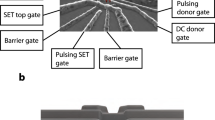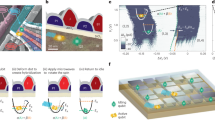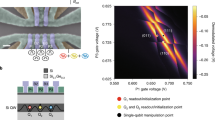Abstract
In recent years, a variety of solid-state qubits has been realized, including quantum dots1,2, superconducting tunnel junctions3,4 and point defects5,6. Owing to its potential compatibility with existing microelectronics, the proposal by Kane7,8—on the basis of phosphorus donors in silicon—has been pursued intensively9,10,11. A key issue of this concept is the readout of the 31P quantum state. Electrical measurements of magnetic resonance have been carried out on single spins12,13, but the statistical nature of these experiments based on random-telegraph-noise measurements has impeded the readout of single spin states. Here, we demonstrate the measurement of the spin state of 31P donor electrons in silicon and the observation of Rabi flops by purely electric means, that is by coherent manipulation of spin-dependent charge-carrier recombination between the 31P donor and paramagnetic localized states at the Si/SiO2 interface. The electron spin information is shown to be coupled through the hyperfine interaction to the 31P nucleus, suggesting that recombination-based readout of nuclear spins is feasible.
This is a preview of subscription content, access via your institution
Access options
Subscribe to this journal
Receive 12 print issues and online access
$259.00 per year
only $21.58 per issue
Buy this article
- Purchase on SpringerLink
- Instant access to full article PDF
Prices may be subject to local taxes which are calculated during checkout




Similar content being viewed by others
References
Elzerman, J. M. et al. Single-shot read-out of an individual electron spin in a quantum dot. Nature 430, 431–435 (2004).
Petta, J. R. et al. Coherent manipulation of coupled electron spins in semiconductor quantum dots. Science 309, 2180–2184 (2005).
Mooij, J. E. et al. Josephson persistent-current qubit. Science 285, 1036–1039 (1999).
Pashkin, Y. A. et al. Quantum oscillations in two coupled charge qubits. Nature 421, 823–826 (2003).
Kennedy, T. et al. Single-qubit operations with the nitrogen-vacancy center in diamond. Phys. Status Solidi B 233, 416–426 (2002).
Jelezko, F. et al. Observation of coherent oscillation of a single nuclear spin and realization of a two-qubit conditional quantum gate. Phys. Rev. Lett. 93, 130501 (2004).
Kane, B. E. A silicon-based nuclear spin quantum computer. Nature 393, 133–137 (1998).
Kane, B. E. Silicon-based quantum computation. Fort. Phys. 48, 1023–1041 (2000).
Vrijen, R. et al. Electron-spin-resonance transistors for quantum computing in silicon-germanium heterostructures. Phys. Rev. A 62, 012306 (2000).
Hollenberg, L. C. L. et al. Charge-based quantum computing using single donors in semiconductors. Phys. Rev. B 69, 113301 (2004).
Clark, R. G. et al. Progress in silicon-based quantum computing. Phil. Trans. R. Soc. Lond. A 361, 1451–1471 (2003).
Xiao, M., Martin, I., Yablonovitch, E. & Jiang, H. W. Electrical detection of the spin resonance of a single electron in a silicon field-effect transistor. Nature 430, 435–439 (2004).
Brandt, M. S. et al. Spin-dependent transport in elemental and compound semiconductors and nanostructures. Phys. Status Solidi C 1, 2056–2078 (2004).
Boehme, C. & Lips, K. Spin-dependent recombination—an electronic readout mechanism for solid state quantum computers. Phys. Status Solidi B 233, 427–435 (2002).
Schmidt, J. & Solomon, I. Modulation de la photoconductivité dans le silicium à basse température par résonance magnétique électronique des impuretés peu profondes. C.R. Acad. Sci. B 263, 169–172 (1966).
Boehme, C. & Lips, K. Electrical detection of spin coherence in silicon. Phys. Rev. Lett. 91, 246603 (2003).
Poindexter, E. H., Caplan, P. J., Deal, B. E. & Razouk, R. R. Interface states and electron spin resonance centers in thermally oxidized (111) and (100) silicon wafers. J. Appl. Phys. 52, 879–884 (1981).
Stesmans, A. & Afanes’ev, V. V. Electron spin resonance features of interface defects in thermal (100) Si/SiO2 . J. Appl. Phys. 83, 2449–2457 (1998).
Kaplan, D., Solomon, I. & Mott, N. F. Explanation of the large spin-dependent recombination effect in semiconductors. J. Phys. Lett. (Paris) 39, L51–L54 (1978).
Boehme, C. & Lips, K. Theory of time-domain measurement of spin-dependent recombination with pulsed electrically detected magnetic resonance. Phys. Rev. B 68, 245105 (2003).
Feher, G. Electron spin resonance experiments on donors in silicon. I. Electronic structure of donors by the electron nuclear double resonance technique. Phys. Rev. 114, 1219–1244 (1959).
Young, C. F. & Poindexter, E. H. Electron paramagnetic resonance of conduction-band electrons in silicon. Phys. Rev. B 55, 16245–16248 (1997).
Boehme, C. & Lips, K. The ultrasensitive electrical detection of spin–Rabi oscillation at paramagnetic defects. Physica B 376, 930–935 (2006).
Rajevac, V. et al. Transport and recombination through weakly coupled localized spin pairs in semiconductors during coherent spin excitation. Phys. Rev. B (in the press); preprint at <http://arxiv.org/abs/cond-mat/0607627> (2006).
Rabi, I. I. Space quantization in a gyrating magnetic field. Phys. Rev. 51, 652–654 (1937).
Maier, D. C. New frontiers in x-band cw-epr sensitivity. Bruker Rep. 144, 13–15 (1997).
McCamey, D. R. et al. Electrically detected magnetic resonance in ion-implanted Si:P nanostructures. Appl. Phys. Lett. 89, 182115 (2006).
Machida, T., Yamazaki, T., Ikushima, K. & Komiyama, S. Coherent control of nuclear-spin system in a quantum-Hall device. Appl. Phys. Lett. 82, 409–414 (2003).
Schenkel, T. et al. Electrical activation and electron spin coherence of ultralow dose antimony implants in silicon. Appl. Phys. Lett. 88, 112101 (2006).
Acknowledgements
This work was financially supported by Deutsche Forschungsgemeinschaft through SFB 631. The sample investigated was grown by G. Vogg and F. Bensch at Fraunhofer IZM in Munich.
Author information
Authors and Affiliations
Corresponding authors
Ethics declarations
Competing interests
The authors declare no competing financial interests.
Rights and permissions
About this article
Cite this article
Stegner, A., Boehme, C., Huebl, H. et al. Electrical detection of coherent 31P spin quantum states. Nature Phys 2, 835–838 (2006). https://doi.org/10.1038/nphys465
Received:
Accepted:
Published:
Issue date:
DOI: https://doi.org/10.1038/nphys465
This article is cited by
-
Coherent electrical readout of defect spins in silicon carbide by photo-ionization at ambient conditions
Nature Communications (2019)
-
Passivation and characterization of charge defects in ambipolar silicon quantum dots
Scientific Reports (2016)
-
Electrical current through individual pairs of phosphorus donor atoms and silicon dangling bonds
Scientific Reports (2016)
-
Hybrid optical–electrical detection of donor electron spins with bound excitons in silicon
Nature Materials (2015)
-
Quantum engineering at the silicon surface using dangling bonds
Nature Communications (2013)



